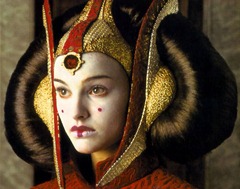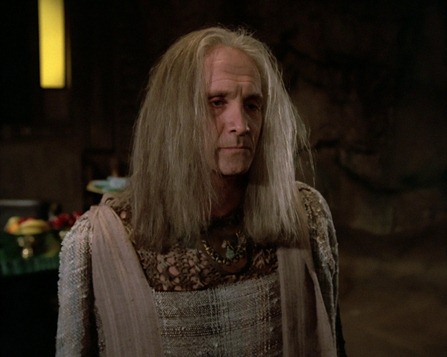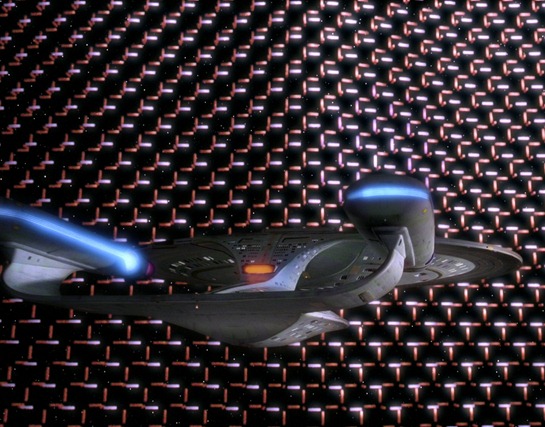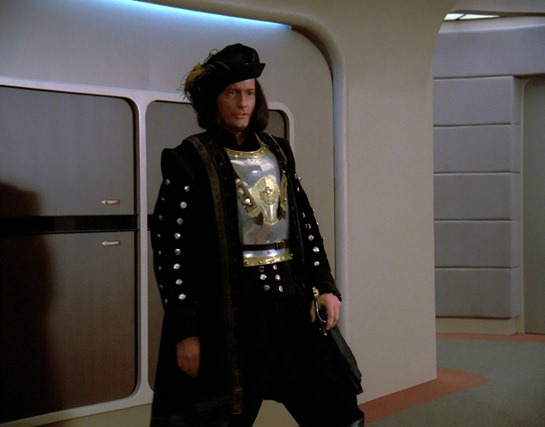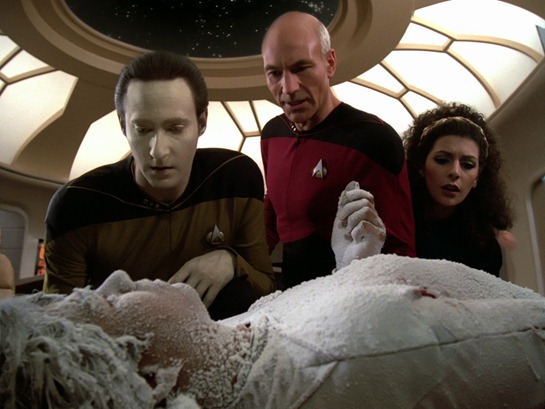Thursday, October 22, 2020
Progress City, USSR
Monday, September 28, 2020
Encounter at Farpoint
“Encounter at Farpoint” is the Phantom Menace of televised Star Trek.
You see, when Star Trek: The Next Generation premiered with “Encounter at Farpoint” in September 1987, it was the first new live-action Star Trek TV episode in almost 20 years. Sure, we'd been getting a new movie every couple of years since 1979, but the fans were desperate for more. The idea of a new weekly show helmed by The Great Bird of the Galaxy Gene Roddenberry himself, remaking Star Trek as only he knew how, sounded great. It was a lot like the excitement Star Wars fans would feel in the 1990s when they learned that George Lucas would be returning to the franchise to make more movies.
And although Star Trek: The Next Generation would end up being a much bigger creative success than the Star Wars prequels, the opening stanza of each is similar in the sense that it’s frequently boring, dysfunctional, and ultimately unsatisfying.
Also, two of their main characters have a very similar fashion sense:
So, let’s take a look at Star Trek: The Next Generation’s maiden outing, and all the weird little problems it has.
Number 1: The Q Subplot
Believe it or not, the character of Q was actually a late addition to the story. Originally, TNG’s premiere was to have been a regular one-hour episode. Veteran Star Trek writer DC Fontana developed a story where the Enterprise comes to the rescue of a peaceful spaceborne lifeform that’s being held captive by an aggressive alien species.
But then someone on the upper end of the food chain decided that Star Trek’s return to television should be a two-hour TV movie “event”. Suddenly, the story had a whole second hour to fill. How would they do it? With one of Gene Roddenberry’s favorite Star Trek tropes: humans proving their moral worth to a skeptical godlike being.
As I’ve written in the past, by the mid-80s Gene Roddenberry was the lone resident of an alternate universe where the sole reason for Star Trek’s success was his high-minded “vision” of the future. He seriously believed that audiences would rather watch characters stand around and debate 24th century philosophy than engage in a fun action-adventure story. And that’s basically the reason for Q’s existence: he’s a foil for Captain Picard to speechify at.
Now don’t get me wrong; John de Lancie did an amazing job bringing life to the character. But if you just read the script, Q comes across as a rather one-dimensional and cartoony villain. Only de Lancie’s performance brings a sense of depth and menace to the character.
Nevertheless, the addition of the Q subplot highlights another huge problem with “Farpoint”:
Number 2: The Actions of the Story’s Major Players Make No Sense
Let’s start with Q. The way he goes about things in this story is pretty nonsensical for a super-intelligent omnipotent being.
First, his major issue is that humans are a “dangerous, savage child race” that has no business being out in space. So when does he choose to appear on the bridge of a human-crewed ship to insist that they return to their own solar system? In the 24th century, after they’ve already been out in interstellar space for a few hundred years. That’s like waiting until the 19th century to demand that Europeans stay on their side of the Atlantic.
And since his problem is that humans have gone too far out into space, then you think he’d direct his complaints to the humans who are farthest away from Earth. And at the top of the show, Picard voiceovers that the Enterprise is en route to Deneb IV, “beyond which lies the unexplored mass of the galaxy”. But when they get to Deneb IV, the USS Hood that dropped off Riker, Geordi, and the rest of the crew is there in orbit. So shouldn’t Q have appeared on the Hood’s bridge and done his whole “humans are a savage race” schtick with their Captain? It’s almost like Q was aware that the Enterprise was the ship with its own TV show, and he wanted to play to the cameras.
Next we have the Bandi, Deneb IV’s cheerful inhabitants:
At some point they managed to capture an giant spaceborne sentient jellyfish with shape-shifting powers and force it to transform into a sleekified version of Walt Disney’s Progress City.
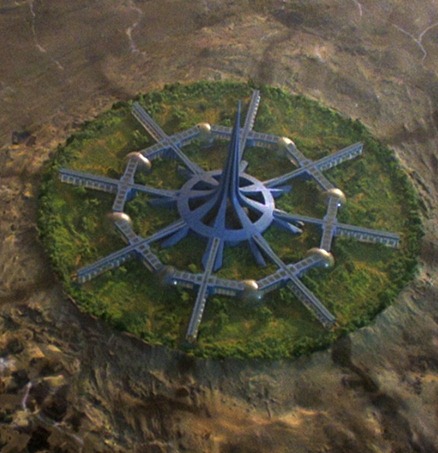 Nice, but where are the monorails?
Nice, but where are the monorails?
Presumably because their planet is the Star Trek equivalent of a third world country, the Bandi christened their new “city” Farpoint Station and used it to attract outside investment from more affluent species. So far, so good. But who’s the first “investor” they try to attract? The Federation, the one group that would have a problem with them exploiting a poor defenseless creature for selfish gain. Why not try the Klingons or the Ferengi?
And then, when Federation representatives like Picard or Riker meet with the Bandi leader, Groppler Zorn, he arouses their suspicion by acting as shifty and defensive as he possibly can. How did this guy manage to become leader of an entire planet? He couldn’t even manage a Burger King! And speaking of people who aren’t qualified for their jobs:
Number Three: A Lot of the Starfleet Officers Are Idiots
Part of Gene’s grand vision of the future was that humanity would “mature” into a peaceful and wise people. One of the ways that TNG’s characters were supposed to differentiate themselves from backwards 20th century humans (besides their preference for spandex pajamas) was their reaction to things that were different and alien.
Since the Enterprise’s mission was to seek contact with strange new worlds, life forms, and civilizations, it would make sense that it be crewed by people who wouldn’t immediately become fearful or violent when they encountered something alien. And if they found themselves in a tight situation, they’d remain cool, calm, and collected like modern-day astronauts or fighter pilots.
With that in mind, let’s examine how these “evolved” 24th Century Roddenberrians react when, in the episode’s opening minutes, they encounter a new kind of alien:
Q announces his presence by throwing up a giant CGI chain-link fence that impedes the Enterprise’s forward progress:
Then, he appears on the bridge dressed as an Elizabethan explorer and talks some trash to Picard using more thees and thous than a performer at a Renaissance Fair.
When some security guards burst onto the bridge with phasers drawn, Q traps them in the turbolift:
So far-and I can’t stress this point enough-Q has done nothing violent. He’s just stopped the ship from moving and been a jerk to everyone. For his part, Captain Picard certainly doesn’t overreact to the situation. He calmly asks Q what he wants and engages him in debate to learn more about this strange new life form. But the people under his command don’t follow his lead.
First, Lieutentant Redshirt McDeadmeat decides that the best way to react to this trash-talking alien with incredible powers is to try to shoot him. Q responds by busting out his Mr. Freeze powers:
Picard is furious, but not at his idiot crewman who tried shoot an alien who hadn’t done anything overtly threatening yet. He’s mad at Q for not letting himself get shot!
So anyway, Q changes costumes a few more times (seriously, he changes clothes more than Queen Amidala. Does he want to put humanity on trial or have a fashion show?) and then disappears, promising to return. Captain Picard decides that since they can’t go forward, they’ll turn the ship around and run away as fast as they can. Unfortunately, Q’s CGI chain-link fence turns into a giant flying Fireball of Doom that pursues them at warp speed.
After Picard decides to separate the saucer to get the children and families out of harm’s way, the command crew transfers to the Battle Bridge. And it is here that we start to wonder how elite this Enterprise crew really is. Because Lieutenant Tasha Yar, Chief of Security, the person responsible for the safety of the Enterprise’s 1000 crewmembers and the officer the Captain relies upon for sound tactical strategy mounts an impassioned plea to get Picard to let her shoot phasers at the Giant Warp Speed Fireball of Doom. As if that would do anything. And a few minutes later during the Q’s courtroom scene she almost gets herself killed when she has a truly hilarious overblown dramatic freakout.
It really makes you wonder what’s going on at Starfleet Headquarters. One imagines that the job of Security Chief on the new Enterprise would be a highly sought-after position. There was probably a big pool of qualified applicants to choose from. So why did Starfleet go with the gun-happy drama queen whose response to anything unexpected is to freak out and try to shoot it?
And then we come to Worf. He doesn’t have much to do in the episode other than be the Token Klingon, an example of Star Trek’s new 24th Century status quo. But there’s this scene two-thirds of the way in where Q appears on the viewscreen to taunt Picard a little bit, and Worf does this:
Yes, he tries to shoot the viewscreen because it’s showing a picture of the bad guy. At this point, Picard should just revoke Worf’s phaser privileges. Heck, he shouldn’t even be allowed to eat with a fork! He’s clearly a danger to himself and others. Still, the Big Dumb Stupid Worf moment does give us something to chuckle at, which is nice because it distracts us from:
Number 4: The Ridiculous Amount of Padding
As I mentioned earlier, the TNG pilot was extended from a one-hour to a two-hour show fairly late in the game. D.C. Fontana was definitely a good-enough writer to come up with an additional hour of material, but Gene Roddenberry was keen that he receive a writing credit on the new show's inaugural episode, so he pulled rank and bolted the Q subplot onto the existing story. Only Roddenberry's skills had deteriorated by 1987 and he wasn't capable of coming up with enough interesting things to fill the additional time.
So what we got was padding. Lots of it.
The padding starts with the initial Q encounter. All that really happens is that Q shows off his costume-changing powers while he and Picard argue about whether humanity is a dangerous savage child race or not.
Then the Enterprise runs away and Q chases them, so they separate the saucer and then Q spirits Picard and company away to his post-apocalyptic courtroom so he and Picard can have basically the same argument they had at the beginning of the show. This renders everything that happened from Q’s first appearance to the start of the courtroom scene ENTIRELY POINTLESS. It would have been much better from a story perspective to have Q bring Picard and his officers into the courtroom for their first encounter.
An even more egregious example of padding happens after Commander Riker comes aboard. Before Picard will talk to him, he makes Riker sit at the back of the bridge and watch what’s essentially a clip reel of the episode up to this point.
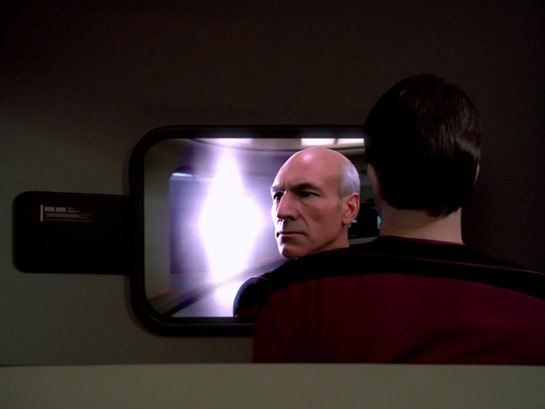 At least Picard could have let him get some popcorn
At least Picard could have let him get some popcorn
Usually your cheesy 80s shows waited until later in the season to have a clip show, when money was tight and the writing staff was out of ideas. Working a clip reel into your pilot episode may be a television first.
Hey, remember that whole “mystery of Farpoint Station” you were supposed to be solving? When are you going to get around to that?
I understand that one of the functions of a pilot episode is to introduce the characters and their world. But a well-written pilot would do that while moving the plot forward. In “Encounter At Farpoint”, however, the plot keeps getting put on hold so we can have these little expository scenes. Don’t get me wrong, some of them are nice. But the constant digressions away from the main story to introduce this or that character or piece of technology really end up hurting the episode because we find ourselves constantly waiting for things to get moving.
Unfortunately, that doesn’t happen until almost three-quarters of the way into the episode. And our characters solve the mystery of Farpoint Station pretty quickly. Which isn’t too surprising, after all Groppler Zorn’s not much smarter than your average Scooby-Doo villain.
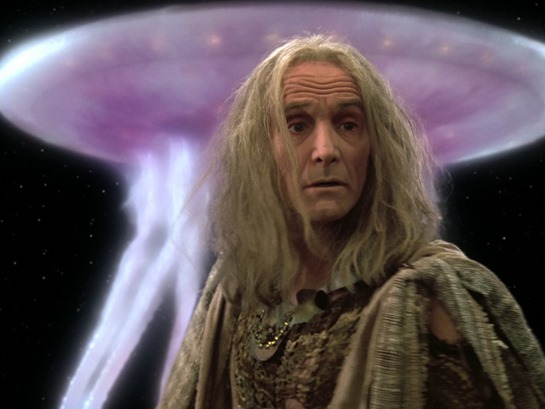 “And I would have gotten away with it too, if it hadn’t been for those nosy kids in their spandex pajamas!”
“And I would have gotten away with it too, if it hadn’t been for those nosy kids in their spandex pajamas!”
It’s certainly better than doing the thing where the solution to the puzzle is blindingly obvious but you need to pad out the episode so you make your characters too stupid to figure it out until there’s only five minutes left. However, it has the unintended side effect of making Q’s promise that the Farpoint mission would be a test of the worthiness of the human race ring a bit hollow.
But wait! Haven’t I forgotten something? Don’t I want to make fun of Wesley Crusher? No. No, I don’t. While some of the scenes with him are part of the unnecessary padding I talked about earlier, I actually like Wesley. I’ll talk more about that in a future post.
But for now, I’ve said my piece about “Encounter at Farpoint”. It’s a weird, dysfunctional couple hours of television. And yet, TNG would get worse before it got better.
If you made it this far, thanks for reading! And if you didn’t make it this far, then I guess it doesn’t matter that this post doesn’t have a clever ending.
Tuesday, August 18, 2020
The Picard Plotting Problem
Way back in the prehistoric mists of 1999, the creative team behind Deep Space Nine closed out the show's seven-year run with a ten-episode finale arc. It was a ridiculous challenge, especially with the hectic pace of 1990s TV production. The writers had never done a ten-episode arc before, and this one had to not only be internally coherent but also wrap up all the threads from the previous seven years of storytelling. And while DS9's finale arc isn't 100% perfect, it's very well-executed. The story hangs together pretty well, and all of the character's actions flow naturally from their pre-existing motivations and personalities.
The writers of Star Trek: Picard were in a much better position. Their ten-episode arc was a standalone story, not the back half of a 26-episode season, and they had much more time to develop it. The majority of the series regulars were original characters, and the few regulars that came from previous Star Treks (i.e. Picard and Seven of Nine) hadn't been seen for years, which gave the writers some creative "wiggle room" in how they'd be portrayed.
So how would this new creative team tell the story of Jean-Luc Picard's twilight years? By giving us a very convoluted, mystery-box story full of flashbacks. Is it good? To help us answer that question, I created this list of all the show's major events in chronological order.
- The planet Romulus is threatened by a supernova, so the Romulans ask the Federation for help to evacuate their solar system. The Federation agrees, somewhat unwillingly, and Admiral Picard oversees the construction of a fleet of transport ships at the Utopia Planitia shipyards on Mars.
- The Utopia Planitia shipyards are using "synths" (i.e.mass-produced not-quite-sentient androids) as unpaid labor. Picard is 100% okay with this, even though he strenuously argued against using androids as slave labor in one of TNG's most pivotal episodes, "The Measure of a Man".
- The head of Starfleet Security, Commodore Oh, is a secret Romulan spy and the leader of an ancient and very secret Tal'Shiar splinter group called the "Zhat Vash" whose sole purpose is to eliminate artificial lifeforms. Her assistant, Lt. Rizzo, is also a disguised Zhat Vash agent named Narissa.
- Why do the Zhat Vash hate androids? It turns out there's a planet in an 8-star solar system that has this laser table thing left behind by a long-dead civilization, and when you touch it it puts images in your brain of an AI-induced holocaust very similar to the one they were trying to prevent in season 2 of Discovery. Anyway, going to the planet and receiving the laser table vision (which they call the Admonition) is part of the Zhat Vash initiation ceremony; those who aren't driven insane by it are left with a fanatical desire to wipe out all artificial life forms to keep them from destroying all the organic life in the universe.
- At this moment of maximum peril for the Romulan people, Commodore Oh and the Zhat Vash decide it's time to scare the Federation into banning all synths. They do this by hacking the synth laborers on Mars to make them attack and destroy the Utopia Planitia shipyards, the very place where the fleet of ships to rescue their people are being built.
- It's safe to say that the synths weren't manufactured overnight. There was probably a long R&D process, too. If the Zhat Vash really believe that the presence of any artificial life will inevitably lead to a universe-spanning Skynet, wouldn't they have sabotaged the project to keep the synths from being created in the first place? Why do they wait until a whole bunch of synths are already built, then hatch a plan that mainly just gets a bunch of Romulans killed? These are excellent questions that nobody (least of all the writers) seem to have considered.
- As a result of the Mars attack the Federation Council immediately bans synths and never conducts an investigation into what caused them to go haywire in the first place. Even though the attack killed millions of people and led to the near-death of an entire race, no one but Picard's former attache Raffi is interested in figuring out why it happened, and everyone treats her like she's crazy. She even loses her Starfleet career.
- The Federation was never that crazy about helping the Romulans anyway, and now that the rescue fleet they were building is gone, they cancel the Romulan relief effort. Picard resigns from Starfleet in protest.
- Since his life's work is now banned, Dr. Bruce Maddox leaves the Daystrom Institute on Earth and sets up shop on the remote world of Coppelius, where he starts building androids based on Data. At some point, Noonien Soong's hitherto-unknown twin son Altan joins him. The Soongs obviously have the same weird genetic condition as the McFly family that causes all male descendants to look exactly alike.
- Five years later the USS ibn Majid encounters two representatives from a unknown race of androids. When the Captain reports to Starfleet, Commodore Oh orders him to kill the androids immediately without trying to learn anything about their origins, threatening to destroy the ibn Majid unless he obeys. She then immediately classifies the incident. I guess the head of Starfleet Security has broad dictator-like powers that are never subject to review by any other Starfleet or civilian authorities. The location of the android's home planet remains a mystery.
- Fifteen years after the attack on Mars, Bruce Maddox sends twin android sisters Dahj and Soji to discover the truth behind the attack and resulting synth ban. However, he erases their memories and implants false ones to make them believe they're human. Supposedly this is to protect them from whatever shadowy anti-synth forces orchestrated the ban, but because they closely resemble one of the androids encountered by the ibn Majid ten years earlier the Zhat Vash instantly recognize them.
- Commodore Oh and the Zhat Vash are suddenly very interested in finding Dahj and Soji's home planet, even though they've known about its existence for the last ten years and haven't bothered trying to find it before now.
- After sending Dahj and Soji on their mission, Maddox leaves the safety of Coppelius and borrows a bunch of money from an underworld figure named Bijayzl (whose main business is chopping up ex-Borg and selling their implants) to set up a new lab on a different, easier-to-find planet.
- The Zhat Vash agents on Earth attack Dahj and try to extract the location of the android homeworld from her brain, but this only serves to "activate" her and she kills them all thanks to her automatic defensive programming. However, this does not restore her memories of who she is, where she came from, and why she was sent to Earth. Instead it triggers kind of a post-hypnotic suggestion to seek refuge with Jean-Luc Picard, a 93-year-old retiree with no idea of what's going on.
- Dahj shows up on Picard's doorstep. He quickly deduces that she's an android "relative" of Data, but because he's just an elderly retired civilian he's unable to stop the Zhat Vash from assassinating her.
- Meanwhile, Soji has been given a job as a guest researcher on a deactivated Borg cube in Romulan space. Maddox placed her here so she could hack into Romulan databases for clues about the truth behind the synth ban. Since a direct, brutal approach failed to get any information from Dahj, Zhat Vash agent Narek (Narissa's loser brother) decides to try a different approach with Soji: he'll use his penis.
- A note about the Borg cube. Narissa and her aunt both underwent the Admonition, but it drove the aunt insane. She was on her way home to Romulus when a Borg cube assimilated her ship, but the effects of the Admonition caused the Borg cube to "break" and it was severed from the Collective. Now it's a dead artifact, and the impoverished remnant of the Romulan Empire makes money by harvesting and selling its tech. They also host research teams from other planets, and even administer a reclamation project where the drones are de-Borged, brought out of suspended animation, and helped to live normal-ish lives.
- Picard learns that Dahj had a twin and resolves to save her from suffering the same fate as her sister. But there's just one problem: he doesn't know where she is. Somehow he figures out that Bruce Maddox may know, if only he can be found. He hires a civilian ship, the La Sirena, recruits his old attache Raffi, and is joined by former Maddox colleague Agnes Jurati.
- The Zhat Vash destroy Bruce Maddox's new lab. He escapes and runs to the shady Borg-butchering criminal he owes money to. It doesn't go well for him.
- Raffi discovers that Maddox is on the planet Freecloud.
- Instead of going directly to Freecloud, Picard orders the La Sirena's Captain Rios to set course for the planet Vashti where a bunch of Romulan refugees live. You see, his motley crew has a traumatized ex-Starfleet pilot, a computer hacker, and a scientist lady, but since they're likely to encounter fanatical Zhat Vash agents who want to kill them with phasers, Picard decides they need a guy who's good with a sword.
- On Vashti, Picard finds his sword guy: a Romulan named Elnor that he abandoned as a child. They also pick up Seven of Nine during a battle with a Romulan pirate ship.
- Picard and friends rescue Maddox from Bijayzl, and Seven kills her in retribution for butchering Icheb years earlier in a horrible, torture-porny scene that has no place in Star Trek.
- Maddox tells Picard where Soji is. When they're alone, Agnes kills Maddox. But she only did it because of a compulsion put into her head by Commodore Oh via mind meld, so she doesn't get in trouble. Apparently "Your Honor, my client only killed that guy because a Romulan mind-meld made her do it" is a valid murder defense in the 24th century.
- Meanwhile, Soji is freaking out as she realizes she's not human. You think this would be a good time for her memories to come back, since full awareness of who she is and why she's on the Borg cube could help her protect herself and maybe even accomplish her mission. But that does not happen. Instead, the gaps in her memories and need for answers allow Narek to get the location of Coppelius from her before abandoning her in a death trap.
- Fortunately, Soji's android abilities kick in and she escapes from the death trap, runs into Picard, and through an extremely fortunate series of events is able to escape with him to the Planet of Rikers.
- After a warm and fuzzy TNG reunion, Picard and Soji rejoin the La Sirena for the trip to Coppelius.
- Also en route to Coppelius: a 200-ship Romulan armada led by Commodore Oh. Up until this moment the post-supernova Romulan Empire has been portrayed as a loose assemblage of third-world refugees. How they were able to build 200 advanced warships isn't explained. It's like if Somalia suddenly had a huge navy of Virginia-class nuclear submarines. Also, if the crippled remains of the post-supernova Romulan Empire are able to build and crew a fleet of 200 giant warships, the full-strength pre-supernova Empire should have been able to build their own evacuation fleet. Why did they need the Federation's help at all? This excellent question is (surprise!) never addressed.
- And now I need to back up a little, because while Picard and Soji were kicking it on the Planet of Rikers, Elnor and Hugh (formerly of Borg) were fighting Romulans on the Cube. Narissa kills Hugh, and then Seven of Nine shows up and leads Elnor to the Queen's chamber. Her plan? To plug herself into the cube and reactivate the dormant Borg drones. Finally, the thing that they've been teasing since the second episode! But it's a huge step. Will Seven be able to retain her humanity? Or will she again be consumed by the Borg? She makes her choice. She plugs in. And then Narissa opens a giant door and all the Borg are blown into space, so Seven just unplugs herself and there are no ill effects.
- Meanwhile, the La Sirena arrives at Coppelius ahead of the Romulan armada, but they've been followed by Narek in a one-man fighter. They fight, and Narek has the upper hand until the Borg cube under Seven's control comes barreling out of a transwarp conduit. Suddenly all the ships are enveloped by giant space flowers and they crash on the planet.
- Picard and friends walk to the android settlement (with a brief detour to the crashed Borg cube to say hi to Elnor and Seven) and meet Dr. Altan Soong and the android Sutra, who looks like a gold-skinned version of Soji and Dahj. Sutra mind-melds with Agnes to see the Admonition for herself and realizes that the Romulans had misunderstood it. They believed it was left by a society that had been wiped out by androids to warn others from suffering the same fate. But was actually left by a society of androids to warn future androids of the danger posed to them by organics, and to promise that an alliance of synthetic life from some extradimensional realm stands ready to rescue them from all organic oppressors.
- Picard wants to evacuate the Coppelius androids on the La Sirena, take them to the Federation, and give an impassioned Picard Speech to compel the government to protect them. Sutra wants to use the information encoded in the Admonition to build a giant antenna to send an SOS to the extradimensional AI alliance, even though there's a very real chance that the Super-AIs will exterminate all the organic lifeforms in the galaxy and maybe even the universe. Not surprisingly, the androids opt for Sutra's plan over the nonagenarian French vintner they just met five minutes ago.
- Also, Picard's terminal disease that we learned about at the beginning of the show is finally starting to take its toll. Dr. Soong shows off a "golem"--basically a blank unfinished android body-- and mentions that he's working on a mind-transfer process. Gee, I wonder what'll happen with that?
- Soji comes around to Sutra's way of thinking and helps her build the giant antenna thing. Meanwhile, Jurati helps Picard escape confinement and they hurry to the La Sirena to try to head off the approaching Romulan fleet.
- On the Borg cube, Narissa is still alive and well. Her and Seven fight, and Seven knocks her into a bottomless pit.
- The La Sirena and the giant space flowers face off against the Romulan armada, and there's lots of flying around and phaser firing. Picard FaceTimes with Soji and gives her an inspiring Picard Speech about what it means to be human. Then a giant Starfleet armada made up of hastily-rendered low-resolution CGI ships warps in .
- The androids briefly activate the antenna, and it shoots an energy beam into space, creating a sky hole through which evil robotic Doc Ock tentacles begin to emerge. But then Altan Soong deactivates Sutra by pressing the Off button on what I assume is a universal remote, and Soji has a change of heart provoked by Picard's "what it means to be human" speech. She turns off the antenna, and the sky hole collapses.
- The Starfleet armada, led by Captain Riker, hails Commodore Oh and tells her to stand down or he'll kick her "treacherous Tal'Shiar ass". The Romulans warp away.
- After Riker has a brief exchange with Picard, the Federation fleet also warps away. Not even one ship hangs around in case the Romulans come back. Picard finally succumbs to his illness and dies.
- Everyone is super sad and depressed because Jean-Luc Picard, star of the show Star Trek: Picard, is dead. CBS has already announced that the show will have a second season, but obviously, season two of Star Trek: Picard will have no Picard in it, because Jean Luc-Picard is dead. Nah, they weren't setting up anything with that blank android body and the mind-transferring machine. We, the audience, are supposed to sit through several sad and weepy scenes with Raffi and Elnor and Seven and Rios as they give voice to the grief that we feel at the irreversible loss of this great man, and believe that his illustrious life has finally come to an end.
- And then Picard wakes up in his study on Earth. Data is there too! A strange, uncanny-valley-looking Data that reminds me of the "young" Jeff Bridges in Tron: Legacy. Is this the afterlife? No, Data explains that it's a "quantum simulation". Drs. Jurati and Soong scanned Picard's brain and downloaded his consciousness here just before he died. As for Data, Dr. Maddox re-created his consciousness from the memories he downloaded into his less-advanced "brother" B-4 in the worst Star Trek movie ever made and he's been "alive" ever since, hanging out inside a futuristic Mr. Coffee on a table in a lab. This raises all kinds of fascinating story possibilities. Maybe Data could download into a new body and meet his "descendants" on Coppelius. Maybe his consciousness could be "rebooted" in the process, allowing the role of Data to be recast as a younger actor. We could see Data live again in one of the more humanlike bodies that Soji and Dahj had, experiencing the human condition instead of merely observing it. But instead, we go back to that old Star Trek trope that there's nothing more human than dying, and Data wants to die. He asks Picard to turn off his simulation when he gets back. He never asks about his best friend Geordi, or any of his other friends from the Enterprise. As far as this show's writers are concerned, Jean-Luc Picard was Data's best and only friend.
- And then Picard wakes up again on Coppelius. Soong and Jurati modified the golem to look like him and then downloaded his consciousness into it. It's implied that Soong might have a terminal illness and had intended the golem for himself, which would mean he made quite a sacrifice for this guy he just met yesterday. But like most interesting plot threads in this show, it's not addressed at all. Now, if you or I were downloaded into an android body we'd want to be younger or better-looking. But not Picard! He still looks and feels like a 90-year-old man, and he likes it that way! No android superpowers or extended lifespan for him! Now reborn, Picard fulfills his promise to Data by turning off the Mr. Coffee that contains his consciousness. Inside the quantum simulation, we see Data grow old and die with Picard at his side.
- We learn that the events on Coppelius have caused the Federation Council to rescind the synth ban. One wonders how, in the space of like two days, the entire Federation learned the whole truth about the events on Coppelius and the Zhat Vash's conspiracy, then went through all the political debate and drafting and passing of legislation necessary to reverse a longstanding policy. Of course, the writers did not wonder about this. They wanted the synth ban to be gone, and so it is with a magical dialogue handwave. What are the implications of this? Does it mean a resumption of android slave labor? And what about Commodore Oh? Will she be brought to justice? Is Starfleet going to conduct some kind of investigation to find out how a Romulan agent managed to worm her way to the top of their organization and find how much damage she did? None of these questions are addressed or even mentioned.
- Picard and his cobbled-together crew are reunited on the La Sirena. Picard looks around appreciatively, and gives the order to "Engage!"
- But wait, where are they going? This isn't a Starfleet vessel on an open-ended exploratory mission, it's a cargo ship for hire. The job Picard hired Captain Rios for is done, so everybody has to go their separate ways now, right? Like, are they just going to fly around and randomly do stuff until the ship runs out of fuel because Rios isn't doing jobs any more and couldn't afford a trip to the gas station?
AND SO, IN EVERY SCENE OF OUR STAR TREK STORY...... translate it into a real life situation. Or,sometimes as useful, try it in your mind as a scenein GUNSMOKE, NAKED CITY, or some similar show.Would you believe the people and the scene if ithappened there?IF YOU'RE ONE OF THOSE WHO ANSWERS: "THE CHARACTER ACTS THAT WAY BECAUSE IT'S SCIENCE FICTION", DON'T CALL US, WE'LL CALL YOU.
Friday, January 17, 2020
How I Learned to Stop Worrying and Respect Star Trek: Voyager
It was the second one. After an exciting, lavishly-produced premiere, Voyager immediately settled into the same kinds of technobabble mystery plots and time paradoxes and Holodeck malfunction episodes that TNG had already done to death. All the elements that were supposed to make the show different--half the crew being Maquis rebels, having limited power and supplies--were pretty quickly abandoned or minimized. Meanwhile, the writers of Deep Space Nine had gone all-in on character development and story arcs. Voyager just seemed juvenile and lazy by comparison.
Sensing that their audience was getting restless, the Voyager producers planned a big change for Season Four. What would it be? More realistic storytelling? Better character development? Less reliance on technobabble to solve story problems? Of course not! Instead we got this:
When Jeri Ryan's Seven of Nine joined the crew, I was a nerdy young adult who really liked attractive women but couldn't seem to get a girlfriend. If there was anyone who for whom the sight of a pretty lady in a sprayed-on outfit could cover the show's multitude of sins, it would theoretically have been me. But it didn't work. In fact, I was angry that they thought a woman in a too-tight leotard would distract the audience from the show's obvious quality issues. Did they really think we were that stupid?
I have to give Voyager's producers credit for one thing: they did more than just cast a Laker Girl to wear the catsuit. Jeri Ryan is an amazing actor who landed one of the most difficult roles in Hollywood and handled it with aplomb. I mean, I've never taken any acting classes, but I'm pretty sure that "former Borg drone who was assimilated as a child" isn't a character type they teach you how to play. She's easily one of the best actors Star Trek has ever had; right up there with Patrick Stewart and Leonard Nimoy. I understand why Kate Mulgrew felt so threatened by her. It's not just because of her looks, it's because she was the best actor in the company.
But as good as Jeri Ryan was, the show's writing continued to be lazy and bad. And from what I was reading on the prehistoric Internet, a lot of other people agreed with me. So I stopped watching. I honestly didn't understand how anyone could possibly like Voyager unless they were a little kid or an idiot or something.
Sometime around 1999 or 2000, I joined the TrekBBS (kids, ask your parents). I never visited the site's Voyager forum; I had nothing nice to say about the show, so why bother? But in the site's "lounge" areas where people socialized and played silly games, I encountered a lot of really smart and fun people. And a lot of them were Voyager fans. So I suppressed my instinct to immediately say "You like that show? What are you, stupid?" and I just listened to what they had to say.
And I finally got it.
Voyager was (and still is) a rarity on television: an action-adventure show where the women are the ones giving orders and figuring out solutions to problems. Nobody talks over Captain Janeway in a meeting, or implies that B'Elanna Torres isn't smart enough to solve engineering problems because she's not a man. And none of the women--not even Seven of Nine in that ridiculous sparkly catsuit with built-in high heels--were there solely to serve as eye candy.
For years Star Trek fans pointed to the occasional guest appearance by a female Captain or Admiral or the handful of times that Dr. Crusher got to do something interesting as proof of the franchise's commitment to gender equality. But Voyager finally gave women and girls characters that they could identify with in the same way that boys and men identified with Kirk, Spock, McCoy, Picard, Sisko, and the rest.
Yeah, Voyager isn't perfect. It was hamstrung by clueless UPN executives and writer-producers who frequently seemed bored with Star Trek (Brannon Braga. I'm talking about Brannon Braga.) But in the end, it did what the best Star Trek has always done: inspire people.



